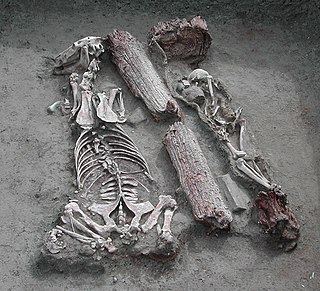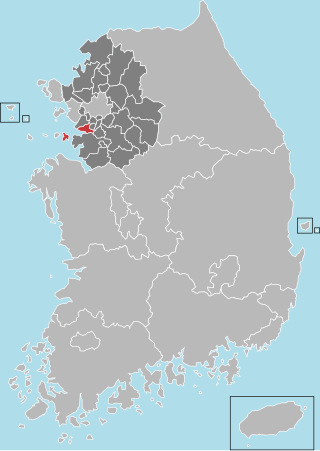Related Research Articles

Chinese art is visual art that originated in or is practiced in China,Greater China or by Chinese artists. Art created by Chinese residing outside of China can also be considered a part of Chinese art when it is based on or draws on Chinese culture,heritage,and history. Early "Stone Age art" dates back to 10,000 BC,mostly consisting of simple pottery and sculptures. After that period,Chinese art,like Chinese history,was typically classified by the succession of ruling dynasties of Chinese emperors,most of which lasted several hundred years. The Palace Museum in Beijing and the National Palace Museum in Taipei contains extensive collections of Chinese art.

Busan,officially Busan Metropolitan City, is South Korea's second most populous city after Seoul,with a population of over 3.3 million inhabitants as of 2024. Formerly romanized as Pusan,it is the economic,cultural and educational center of southeastern South Korea,with its port being South Korea's busiest and the sixth-busiest in the world. The surrounding "Southeastern Maritime Industrial Region" is South Korea's largest industrial area. The large volumes of port traffic and urban population in excess of 1 million make Busan a Large-Port metropolis using the Southampton System of Port-City classification. As of 2019,Busan Port is the primary port in Korea and the world's sixth-largest container port.

The Mausoleum at Halicarnassus or Tomb of Mausolus was a tomb built between 353 and 350 BC in Halicarnassus for Mausolus,an Anatolian from Caria and a satrap in the Achaemenid Persian Empire,and his sister-wife Artemisia II of Caria. The structure was designed by the Greek architects Satyros and Pythius of Priene. Its elevated tomb structure is derived from the tombs of neighbouring Lycia,a territory Mausolus had invaded and annexed c. 360 BC,such as the Nereid Monument.

The Pazyrykburials are a number of Scythian (Saka) Iron Age tombs found in the Pazyryk Valley and the Ukok plateau in the Altai Mountains,Siberia,south of the modern city of Novosibirsk,Russia;the site is close to the borders with China,Kazakhstan and Mongolia.

A ship burial or boat grave is a burial in which a ship or boat is used either as the tomb for the dead and the grave goods,or as a part of the grave goods itself. If the ship is very small,it is called a boat grave. This style of burial was practiced by various seafaring cultures in Asia and Europe. Notable ship burial practices include those by the Germanic peoples,particularly by Viking Age Norsemen,as well as the pre-colonial ship burials described in the Boxer Codex in the Philippines.

A kurgan is a type of tumulus constructed over a grave,often characterized by containing a single human body along with grave vessels,weapons and horses. Originally in use on the Pontic–Caspian steppe,kurgans spread into much of Central Asia and Eastern,Southeast,Western and Northern Europe during the 3rd millennium BC.

Kiya was one of the wives of the Egyptian Pharaoh Akhenaten. Little is known about her,and her actions and roles are poorly documented in the historical record,in contrast to those of Akhenaten's 'Great royal wife',Nefertiti. Her unusual name suggests that she may originally have been a Mitanni princess. Surviving evidence demonstrates that Kiya was an important figure at Akhenaten's court during the middle years of his reign,when she had a daughter with him. She disappears from history a few years before her royal husband's death. In previous years,she was thought to be mother of Tutankhamun,but recent DNA evidence suggests this is unlikely.

South Gyeongsang Province is a province in the southeast of South Korea. The provincial capital is at Changwon. It is adjacent to the major metropolitan center and port of Busan. The UNESCO World Heritage Site Haeinsa,a Buddhist temple that houses the Tripitaka Koreana and tourist attraction,is located in this province. Automobile and petrochemical factories are largely concentrated along the southern part of the province,extending from Ulsan through Busan,Changwon,and Jinju.

South Korea is made up of 22 first-tier administrative divisions:6 metropolitan cities,1 special city,1 special self-governing city,and 14 provinces,including three special self-governing provinces and five claimed by the ROK government. These are further subdivided into a variety of smaller entities,including cities,counties,districts,towns,townships,neighborhoods and villages.

Ansan is a city in Gyeonggi Province,South Korea. It lies southwest of Seoul and is part of the Seoul National Capital Area. It is connected to Seoul by rail via Seoul Subway Line 4. It is situated on the Yellow Sea coast and some islands lie within its jurisdiction. The largest and best-known of these is Daebu Island.

Korean ceramic history begins with the oldest earthenware from around 8000 BC. Throughout the history,the Korean peninsula has been home to lively,innovative,and sophisticated art making. Long periods of stability have allowed for the establishment of spiritual traditions,and artisan technologies specific to the region. Korean ceramics in Neolithic period have a unique geometric patterns of sunshine,or it is decorated with twists. In Southern part of Korea,Mumun pottery were popular. Mumun togi used specific minerals to make colors of red and black. Korean pottery developed a distinct style of its own,with its own shapes,such as the moon jar or Buncheong sagi which is a new form between earthenware and porcelain,white clay inlay celadon of Goryeo,and later styles like minimalism that represents Korean Joseon philosophers' idea. Many talented Korean potters were captured and brought to Japan during the invasions of Korea,where they heavily contributed to advancing Japanese pottery. Arita ware,founded by Yi Sam-pyeong opened a new era of porcelain in Japan. Another Japanese representative porcelain,Satsuma ware was also founded by Dang-gil Shim and Pyeong-ui Park. 14th generation of Su-kwan Shim have been using the same name to his grandfather and father to honor they are originally Korean,14th Su-kwan Shim is honorable citizen of Namwon,Korea.

Ancient Egyptian art refers to art produced in ancient Egypt between the 6th millennium BC and the 4th century AD,spanning from Prehistoric Egypt until the Christianization of Roman Egypt. It includes paintings,sculptures,drawings on papyrus,faience,jewelry,ivories,architecture,and other art media. It was a conservative tradition whose style changed very little over time. Much of the surviving examples comes from tombs and monuments,giving insight into the ancient Egyptian afterlife beliefs.

Dongnae District is a gu in central Busan,South Korea.

Tourism in South Korea and its industry caters to both foreign and domestic tourists. In 2019,17.5 million foreign tourists visited South Korea,making it the 20th most visited country in the world. Most non-Korean tourists come from East Asia and North America,such as Taiwan and the United States. The popularity of Korean popular culture,often known as the "Korean Wave",in countries around the world has significantly increased tourist arrivals.

Geumjeong District is a district in north central Busan,South Korea. Approximately 7.3% of Busan's population is in Geumjeong-gu. The Hoedong Reservoir is located on the district's eastern boundary,and the mountain Geumjeongsan on the west. Because of this,75% of the district's land is restricted from residential development. The district's population is concentrated in the valley of the Oncheoncheon stream,a tributary of the Suyeonggang.

Dongnaeeupseong (Korean: 동래읍성) is a Goryeo-era Korean fortress in Dongnae District,Busan,South Korea. it is located on the mountain Maansan.

Funerary art is any work of art forming,or placed in,a repository for the remains of the dead. The term encompasses a wide variety of forms,including cenotaphs,tomb-like monuments which do not contain human remains,and communal memorials to the dead,such as war memorials,which may or may not contain remains,and a range of prehistoric megalithic constructs. Funerary art may serve many cultural functions. It can play a role in burial rites,serve as an article for use by the dead in the afterlife,and celebrate the life and accomplishments of the dead,whether as part of kinship-centred practices of ancestor veneration or as a publicly directed dynastic display. It can also function as a reminder of the mortality of humankind,as an expression of cultural values and roles,and help to propitiate the spirits of the dead,maintaining their benevolence and preventing their unwelcome intrusion into the lives of the living.

Busan Metro Line 4 is a rubber-tyred metro line of the Busan Metro network that connects part of Gijang-gun,Busan,and upper Haeundae-gu,Busan,into Dongnae-gu,Busan Korea. It is operated by the Busan Transportation Corporation. Opened on 30 March 2011,the line is a rapid transit (metro) system consisting of 14 stations - 8 underground,1 on-ground,and 5 above-ground. The line color is blue. A trip through the entire line takes about 24 minutes. Unlike lines 1 to 3 of Busan Metro,the trains are driverless and run with pneumatic tires on concrete track between two guide bars. Line 4 was originally planned to be simply a branch of Line 3,but was turned into its own line later.

Geumseong is a dong,or precinct,in Geumjeong-gu,Busan,South Korea. A lightly populated district,it is situated entirely within the mountain range of Geumjeongsan. It is bounded to the west by Hwamyeong-dong and Geumgok-dong in Buk District,to the northwest by Dong-myeon of Yangsan City,to the east by Cheongnyong-dong,Namsan-dong,Guseo-dong,and Jangjeon-dong of Geumjeong-gu,and to the south by Oncheon-dong in Dongnae-gu. The northernmost point in Geumseong-dong is at Godang-bong,the highest peak in Geumjeongsan.

Busan Museum (Korean: 부산광역시립박물관) is a museum located in Busan,South Korea,open since 1978.
References
- ↑ "Bokcheon Museum — Ancient Tombs Park". Busan Metropolitan City Government.